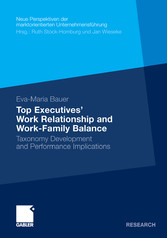Suchen und Finden
Mehr zum Inhalt

Top Executives' Work Relationship and Work-Family Balance - Taxonomy Development and Performance Implications
3 Basics of the Empirical Studies (S. 71-72)
As outlined before, the empirical part of the taxonomy development procedure consists of a qualitative and a quantitative study. The basics of these studies, concerning both taxonomies, namely the data collection procedures, the samples and the analysis techniques will be outlined in the following. First, in chapter 3.1 the basics of the qualitative study will be outlined, followed by the basics of the quantitative studying in chapter 3.2.
3.1 Qualitative Study
The purpose of the qualitative study within the empirical portion of our taxonomy development process focuses on enriching and elaborating the theory-based frameworks of our taxonomies. The content-related issues concerning top executives’ work relationship and workfamily balance will be outlined in later sections of this thesis (see chapter 3.2.4 and 5). In the following the basics of the qualitative study will be presented, that is to say the data collection and sample (see section 3.1.1) and the content analysis technique used to evaluate and interpret the qualitative data (see section 3.1.2).
3.1.1 Data Collection and Sample
For participant acquisition, we contacted 44 top executives by an initial letter and then telephone solicitations and asked them to give us a personal interview on their work-life balance situation. These top executives were members of the top management, “including CEOs and their immediate subordinates” (Eisenhardt/Bourgeois 1988, p. 739). Thus, in addition to CEOs, our sample includes “the heads of major functions such as sales, engineering, and finance” (Eisenhardt/Bourgeois 1988, p. 739). As an incentive, we offered a detailed personalized report of their personal resources compared with those of other top executives, as well as recommendations for ways they could handle job-related demands and ameliorate their worklife balance situation.
As a result, 42 top executives accepted to participate, whereas only two did not participate because of time constraints. The top executives in the sample were 88 percent men, 95 percent married or close-partnered and 90 percent had children. They had an average age of 50.8 years and an average of 17 years of work experience as top executive. The companies were located in a wide array of industrial sectors (e.g., automotive industry, building and construction industry, chemical and pharmaceutical industry, consulting, and publicshing industry). With this heterogeneous sample regarding age, tenure, and industries, we intended to generate a wide array of top executives’ perceived work relationship and work-family balance situation. In order to approve the theoretically derived facets and constructs of top executives’ work relationship and work-family balance, we collected data through semistructured interviews with individual respondents.
Alle Preise verstehen sich inklusive der gesetzlichen MwSt.







